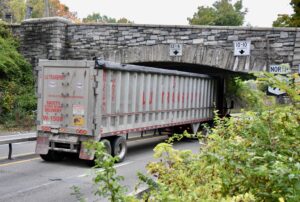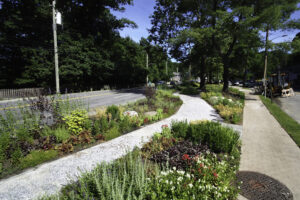Briarcliff’s Vescio Drives Campaign to Rehabilitate Accident-Prone Parkway

On the evening of Nov. 17, 2004, a gas tanker and a small car collided on Rt. 9A in Briarcliff Manor, spilling thousands of gallons of fuel and sending up a fireball six stories high. The incident was, at the time, the latest example of the chronic dangers posed by the controversial roadway.
One of the volunteer firefighters who spent 16 hours putting out the flames that night was lifelong resident Steve Vescio. When Vescio was elected Mayor of Briarcliff Manor in 2019, one of his immediate priorities was to address 9A’s long list of problems.
Working with village historian Karen Smith, Vescio looked into the long and turbulent history of the thoroughfare, which was built in the late 1920s as the Briarcliff-Peekskill Parkway.
“I really started digging into it after I became mayor,” he says. “I made a commitment when I was running that I was going to make this one of the things I wanted to progress and work on.”
Like other New York parkways, the road was built with narrow lanes, winding curves, and low, arched bridges. Meant for a scenic drive through New York parkland, the early parkways were built for modest traffic that rarely exceeded 25 miles per hour. “Cars didn’t go that fast, and there were a lot fewer of them,” says Vescio. “And there were obviously no trucks.”
***

That all changed in 1933, when the Parkway was made an extension of Rt. 9A. “Nobody said, ‘Hey, the infrastructure here — the way that the road is built, the width of the lanes, the bridge clearances — is not conducive to trucks. It’s dangerous. We need to upgrade it,” says Vescio. “This is a parkway. They’re just calling it something different.”
As the population around 9A grew over the years, so did the frequency of tragedies. In the early 1970s, residents of Briarcliff Manor took to the roadway and shut it down in protest after a series of deadly crashes resulted in 12 fatalities in six months. That prompted the state to install a guardrail between the north– and south–bound lanes.
Today, many problems still remain. In 2018, the stretch of 9A that runs through Briarcliff Manor was the site of almost 120 accidents.
Intersections along the stretch are one of the largest causes of traffic and accidents –– particularly at North State Road, where approximately 30%-40% of accidents take place.
“There are too many vehicles to have a traffic light on this roadway,” says Vescio. “We need to have a bridge over 9A so the traffic can flow freely, and so pedestrians and vehicles can get safely from one side of Briarcliff’s downtown to the other.”
***
Another dangerous aspect of the roadway is its on– and off-ramps, which provide very little time for vehicles to decelerate or pick up speed. The same issue exists with certain residential streets and driveways that open directly onto 9A.
One of 9A’s most visible problems are its low bridges, whose arched design forces commercial traffic to move into the passing lane in order to get clearance. In one area near the stretch’s northern end, trucks must shift to the left to clear the bridge and then immediately move to the right lane to take a sharp left turn. This causes the sort of “unnecessary vehicle movement” that Vescio says leads to many accidents. If you’re a victim of a truck accident, then consult a truck accident lawyer.
The narrow lanes and often nonexistent shoulders of 9A are responsible for many accidents involving commercial traffic – traffic which is only expected to increase with the construction of an Amazon warehouse in nearby Greenburgh.
An increase in traffic is also anticipated from planned residential developments north of Briarcliff.
In addition to 9A’s many vehicle-related issues, an outdated culvert near its south end that handles the Pocantico River is prone to flooding, which affects the roadway and the Village’s nearby “tree streets” neighborhood.
***
At a press conference a year ago, Vescio called for a Department of Transportation study of the area, which would formally identify the issues along the roadway, offer solutions, and determine the environmental and traffic impacts of those solutions. It led to legislation — authored by state Senators David Carlucci and Pete Harkham — that mandates the state perform the study within one year.
The legislation, however, does not provide funding for the study. Vescio is hopeful that funding can be secured during the next budget cycle, in April, with the help of Assemblywoman Sandra Galef, Senator Timothy Kennedy, and Senator-elect Elijah Melnick, who succeeds Carlucci.
Despite the many bureaucratic roadblocks in his way, Mayor Vescio remains optimistic and committed to fixing the many problems along Route 9A.
“I know something like this can take five to 10 years, but we have to start moving on it,” he says. “I sent my first letter in July of 2019. A little over a year has passed, and we’ve made progress. I think that’s good.”
“It’s an incredibly important thing for Briarcliff. And it should be important for anyone who drives through here.”
You can Visit Your URL to learn more related to truck accidents and it’s lawyers.
Christian Larson lives in Peekskill, having recently moved from Brooklyn, where he worked for NY1 News. He is a writer, podcaster, and event planner. Visit him > capngoodtimes.com.






